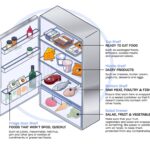Managing chronic kidney disease (CKD) often involves making significant dietary adjustments. Working with a registered dietitian is crucial for creating a personalized meal plan that aligns with your preferences and supports kidney health. This guide outlines key food restrictions and dietary considerations for individuals with CKD, empowering you to make informed choices.
Eating Right for Kidney Health: Essential Steps
These steps are crucial for managing kidney disease. The first three are important for everyone with kidney disease. The last two become important as kidney function declines.
1. Reduce Sodium Intake: Protect Your Blood Pressure
Why? High sodium intake elevates blood pressure, exacerbating kidney damage. Aim for less than 2,300 milligrams of sodium per day.
- Prioritize Fresh Foods: Limit processed and packaged foods, restaurant meals, and fast food, which are often loaded with sodium.
- Home Cooking is Key: Prepare meals from scratch to control sodium content.
- Flavor with Herbs and Spices: Substitute salt with herbs, spices, and sodium-free seasonings.
- Read Nutrition Labels Carefully: Pay close attention to the “Daily Value” percentage for sodium. 20% or more indicates a high-sodium food.
- Opt for Lower-Sodium Alternatives: Choose low-sodium versions of convenience foods.
- Rinse Canned Goods: Rinse canned vegetables, beans, meats, and fish to remove excess sodium.
Alt text: Nutrition label showing a Percent Daily Value of 5% or less for sodium, indicating a low-sodium food choice.
2. Control Protein Intake: Protect Your Kidneys
Why? When your body processes protein, it creates waste that the kidneys must filter. Excessive protein intake forces the kidneys to work harder.
-
Moderate Portion Sizes: Consume protein in small portions.
-
Balance Animal and Plant Proteins: Discuss the optimal balance of animal and plant-based protein sources with your dietitian.
- Animal Protein Sources:
- Chicken
- Fish
- Meat
- Eggs
- Dairy
A cooked portion of chicken, fish, or meat should be about 2-3 ounces, roughly the size of a deck of cards. A serving of dairy is ½ cup of milk or yogurt or one slice of cheese.
- Plant Protein Sources:
- Beans
- Nuts
- Grains
A serving of cooked beans is about ½ cup, and a portion of nuts is ¼ cup. A slice of bread is one serving, while a ½ cup of cooked rice or noodles is one serving.
- Animal Protein Sources:
3. Choose Heart-Healthy Foods: Protect Your Cardiovascular System
Why? Limiting saturated and trans fats helps prevent plaque buildup in blood vessels, protecting both your heart and kidneys.
-
Opt for Healthy Cooking Methods: Grill, broil, bake, roast, or stir-fry instead of deep-frying.
-
Use Healthy Oils: Cook with nonstick spray or small amounts of olive oil instead of butter.
-
Trim Fat and Remove Skin: Remove excess fat from meat and skin from poultry before cooking.
-
Limit Unhealthy Fats: Minimize saturated and trans fats.
- Heart-Healthy Options:
- Lean meats (loin or round cuts)
- Skinless poultry
- Fish
- Beans
- Vegetables
- Fruits
- Low-fat or fat-free dairy products
- Heart-Healthy Options:
Alt text: Senior couple collaboratively preparing a nutritious, heart-healthy meal in their kitchen.
- Limit Alcohol Consumption: Moderate alcohol intake is crucial. Women should have no more than one drink per day, and men should have no more than two. Consult your healthcare provider about safe alcohol consumption levels.
Advanced CKD: Further Dietary Restrictions
As kidney function declines, you may need to limit phosphorus and potassium intake. Regular blood tests will help your healthcare provider and dietitian adjust your meal plan.
4. Limit Phosphorus Intake: Protect Your Bones and Blood Vessels
Why? In CKD, phosphorus can accumulate in the blood. High phosphorus levels can leach calcium from bones, weakening them. They can also cause itchy skin and bone/joint pain.
- Avoid Processed Foods with Added Phosphorus: Check ingredient labels for phosphorus or ingredients containing “PHOS.”
- Choose Fresh Meats Carefully: Deli meats and some fresh meats and poultry may contain added phosphorus. Ask your butcher for assistance in selecting fresh meats without added phosphorus.
| Foods Lower in Phosphorus | Foods Higher in Phosphorus |
|---|---|
| Fresh fruits and vegetables | Meat, poultry, fish |
| Breads, pasta, rice | Bran cereals and oatmeal |
| Rice milk (not enriched) | Dairy foods |
| Corn and rice cereals | Beans, lentils, nuts |
| Light-colored sodas/pop, such as lemon-lime or homemade iced tea | Dark-colored sodas/pop, fruit punch, some bottled or canned iced teas that have added phosphorus |
- Phosphate Binders: Your healthcare provider might prescribe phosphate binders to take with meals. These medications bind to phosphorus in the stomach, preventing its absorption into the bloodstream.
5. Manage Potassium Intake: Support Nerve and Muscle Function
Why? Maintaining proper potassium levels is crucial for nerve and muscle function. Damaged kidneys can lead to potassium buildup, potentially causing serious heart problems.
- Avoid Salt Substitutes: Many salt substitutes are high in potassium. Always check the ingredient label and consult your provider before using them.
- Drain Canned Fruits and Vegetables: Drain canned items before consumption to reduce potassium content.
| Foods Lower in Potassium | Foods Higher in Potassium |
|---|---|
| Apples, peaches | Oranges, bananas, and orange juice |
| Carrots, green beans | Potatoes, tomatoes |
| White bread and pasta | Brown and wild rice |
| White rice | Bran cereals |
| Rice milk (not enriched) | Dairy foods |
| Cooked rice and wheat cereals, grits | Whole-wheat bread and pasta |
| Apple, grape, or cranberry juice | Beans and nuts |
- Medication Review: Certain medications can increase potassium levels. Your healthcare provider may adjust your medication regimen as needed.
By understanding which foods to limit and focusing on a kidney-friendly diet, you can actively manage your CKD and promote overall health. Always consult with your healthcare provider and a registered dietitian for personalized guidance.
